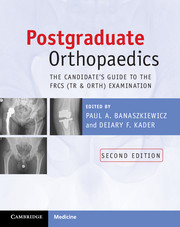Book contents
- Frontmatter
- Contents
- Contributors
- Foreword
- Preface to second edition
- Abbreviations
- Section 1 The FRCS (Tr & Orth) examination
- Section 2 The written paper
- Section 3 The clinicals
- Chapter 3 The short cases
- Chapter 4 The intermediate cases
- Chapter 5 Shoulder and elbow clinical cases
- Chapter 6 Hand and wrist clinical cases
- Chapter 7 Spine clinical cases
- Chapter 8 Hip clinical cases
- Chapter 9 Knee clinical cases
- Chapter 10 Foot and ankle clinical cases
- Chapter 11 Paediatric clinical cases
- Section 4 The adult elective orthopaedics oral
- Section 5 The hand oral
- Section 6 The paediatric oral
- Section 7 The trauma oral
- Section 8 The basic science oral
- Section 9 Miscellaneous topics
- Index
Chapter 4 - The intermediate cases
from Section 3 - The clinicals
- Frontmatter
- Contents
- Contributors
- Foreword
- Preface to second edition
- Abbreviations
- Section 1 The FRCS (Tr & Orth) examination
- Section 2 The written paper
- Section 3 The clinicals
- Chapter 3 The short cases
- Chapter 4 The intermediate cases
- Chapter 5 Shoulder and elbow clinical cases
- Chapter 6 Hand and wrist clinical cases
- Chapter 7 Spine clinical cases
- Chapter 8 Hip clinical cases
- Chapter 9 Knee clinical cases
- Chapter 10 Foot and ankle clinical cases
- Chapter 11 Paediatric clinical cases
- Section 4 The adult elective orthopaedics oral
- Section 5 The hand oral
- Section 6 The paediatric oral
- Section 7 The trauma oral
- Section 8 The basic science oral
- Section 9 Miscellaneous topics
- Index
Summary
Old versus new
The clinical exams underwent a major change in November 2009 with the introduction of the intermediate cases, which replaced the long case. Previously candidates were examined on a long case, with 30 minutes allocated for one case only. This long case would put fear into any candidate, and it represented 25% of your total mark! If you failed the long case, you generally failed the exam. Candidates had an opportunity to elicit a history and examine the patient, and this was then followed by a discussion with the examiners. The long case was removed as it was seen as unfair – if you had a really bad day, you had very little chance to redeem yourself. Candidates are now given intermediate cases and spend 15 minutes each on two patients. Each 15-minute slot is further subdivided roughly into 5 minutes each for history-taking, demonstrating appropriate clinical signs and discussion based on the particular case. As a word of warning, these 5 minute-slots are frequently not enforced by the examiners and you can easily mess the timing up. Certainly I spent about 1 minute on history in one of my intermediate cases and had to go back and ask more questions later! This is not good! Each subsection is marked equally, so it is important to get all the points in all the sections, which means trying to spend adequate time on all three sections. Don't rush the first two and lose easy marks and try and make it up in the discussion. The candidate is never left alone with the patient and all parts of the history and examinations are directly observed. There is a different set of examiners for each of the two intermediate cases. Candidates are allocated any case combinations, such as upper limb/lower limb, paeds/lower limb, lower limb/lower limb, etc.
Most candidates feel that this change is a positive step as it divides the risk. In the past, if a candidate performed poorly in the long case, it was extremely difficult to make this up in the rest of the examination sections as the long case was very heavily weighted. In the new system, even if one intermediate case doesn't go so well, it is easier to compensate elsewhere. Also, as the examiners are observing all the proceedings, they are able to empathize in situations where a patient is a poor historian or the clinical signs are difficult to elicit in a particular case. On the other hand, some candidates feel pressured for time, especially in a more complex case, and find themselves hurrying up and missing important points in the history and examination. Also, some candidates can find the presence of the examiners unnerving, with no scope for repeating and checking clinical signs. If you are unsure of a clinical sign, e.g. ACL rupture, then just re-examine the knee. This is what you would do in clinic, so do it in the exam – don't make it more difficult for yourself!
- Type
- Chapter
- Information
- Postgraduate OrthopaedicsThe Candidate's Guide to the FRCS (Tr and Orth) Examination, pp. 21 - 23Publisher: Cambridge University PressPrint publication year: 2012



